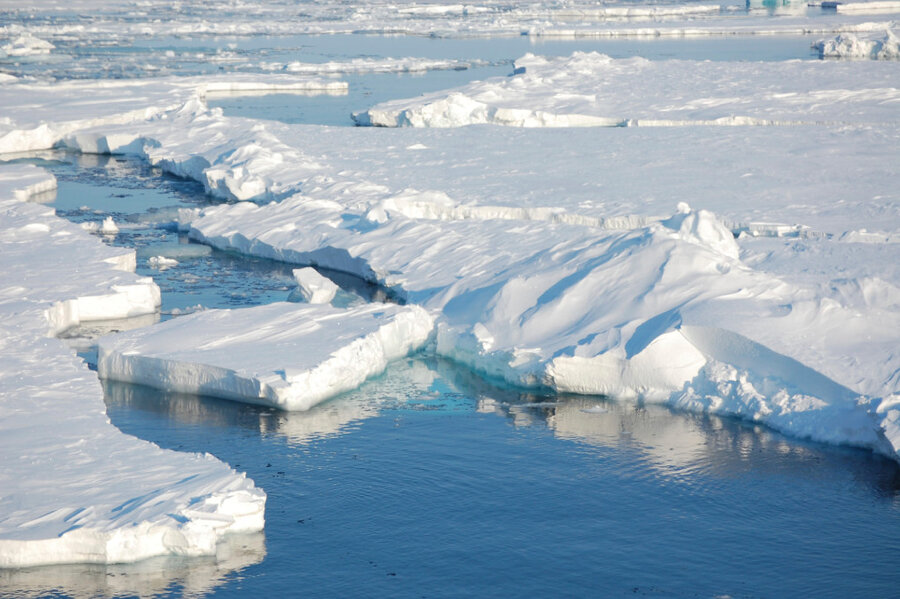Sea ice hits record low: Why is that a big deal?
Loading...
Sea ice, which forms and melts annually, has declined more than 30 percent in the past 25 years. This year, however, Antarctica and the Arctic both reached the lowest levels of sea ice ever recorded since scientists began keeping track in 1979, holding consequences that affect temperatures across the world and strong evidence of the effects of climate change.
On Nov. 20, the National Snow & Ice Data Center measured 8.625 million square kilometers of sea ice, down from the previous record low of 9.632 million square kilometers in 2012, The Boston Globe reports. On the same day the Antarctic – which has actually been increasing for several years hitting a record high in 2014 – showed 13.616 million square kilometers of sea ice, while the previous record low was 14.7 million square kilometers in 1986, according to The Boston Globe.
“Atmospheric temperatures are rising because of heat-trapping gases in the atmosphere so we have overloaded our atmosphere with carbon, so the air temperatures are warmer which in turn can raise temperatures above the freezing point and melt the ice from above,” says Brenda Ekwurzel, the director of climate science for the Union of Concerned Scientists, in Washington D.C.
Sea ice essentially acts as an air conditioner for the world, moderating global temperatures and creating a place for the heat brought in at the tropics to escape to so that the Earth does not simply grow exponentially hotter, Dr. Ekwurzel tells The Christian Science Monitor in a phone interview.
Additionally, anything white – snow, ice, glaciers, or ice sheets – will reflect energy from the sun back into space, helping to keep the Earth cool through a process known as the albedo effect. But when the ice melts, the sun hits the dark ocean waters instead, which absorbs rather than reflects the sun’s energy.
“In ice-covered regions, when ice starts shrinking and melting you have an amplification of the warming that is far greater than in other parts of the world,” says Ekwurzel. “About 70 percent of the Earth is covered with ocean. Sunlight hitting the ocean warms it up and then if that heat doesn’t escape back into space or redistribute into the polar regions as much as it used to in the past, then the oceans are also warming up.”
Sea ice melts annually, and so as summer approaches in the Southern Hemisphere, sea ice melting is to be expected, but the melting this year is more dramatic, Claire Parkinson, a climatologist at NASA’s Goddard Space Flight Center, told The Boston Globe.
In the Northern Hemisphere, sea ice typically increases during this time of year as winter sets in, however, higher than normal ocean temperatures left over from an abnormally warm summer and warm winds continually blown in from the south have caused ice growth to slow down to a near halt this year.
Any change in the annual sea ice melting cycle will have consequences for the cycle further down the line, researchers say, as well as the marine life in the Arctic and Antarctic.
A low level of ice during a warm summer led to a warmer autumn, which in turn reduced the difference in temperature between the Arctic and the tropics, marine and coastal science professor Jennifer Francis of Rutgers University, told the Guardian.
“This helped make the jet stream wavier and allowed more heat and moisture to be driven into Arctic latitudes and perpetuate the warmth. It’s a vicious circle,” she added.
Sea ice melting does not directly contribute to sea level rise because it is already floating on the ocean. It does, however, warm the oceans, which causes the ice shelves and land ice (including glaciers) to melt, and in turn does contribute to sea level rise.
Ekwurzel compared the melting going on under the ice shelves to the weakening of a buttress of a gothic cathedral.
“Once warmer ocean waters are able to get in and penetrate deeper ... once you pull away those buttresses, then the interior of the West Antarctic ice sheet can start flowing rapidly to the ocean and that is land ice,” she tells the Monitor. “Land ice coming into the ocean can directly contribute to sea level rise – seven meters of potential sea level rise.”






